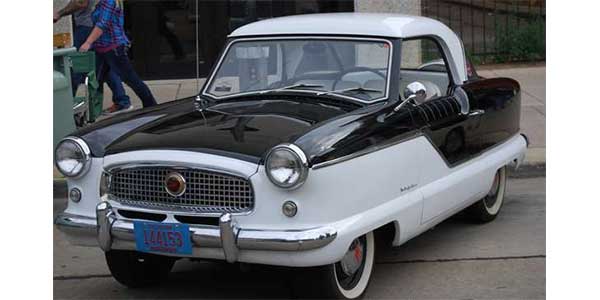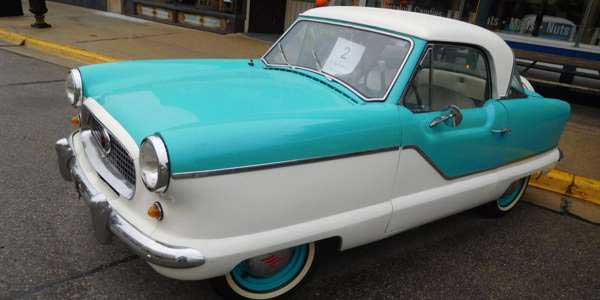
A brand new sub-compact car called the Metropolitan became available at Nash/Hudson dealerships in 1954, the same year that those two automakers merged to become American Motors Corp. The “Metro” or “Met” evolved from a prewar Nash idea for a small, but full-featured, high-quality automobile. It was based on a prototype vehicle called the NXI (Nash Experimental International).
The Metro became a reality when a Nash executive bumped into a British automaker on a cruise ship. An Austin A40 drive train was employed. Metropolitan bodies were built by Fisher & Ludlow in Birmingham, England and shipped to the Austin factory in Longbridge, England for final assembly. The cars were then sent to Nash (and later Hudson) dealers in the United States.
In 1955, Nash continued to market the 85-in. wheelbase Metropolitan, which was produced in England. Nash dealers and Hudson dealers sold it in the United States. The sub-compact came as a $1,445 hardtop or a $1,469 convertible. It was again powered by the 73-cid 42-hp Austin A-40 four-cylinder engine. A total of 6,096 Metropolitans were produced in calendar-year 1955.

In 1956, the original 42-hp Met remained available at many Nash dealers, but the true 1956 Metropolitans were second-generation cars with a new Austin A-50 engine. This 1489-cc overhead-valve four put out 52 hp at 4500 rpm and 77 lb.-ft. of torque at 2500 rpm. It used a Zenith one-barrel downdraft carb. With the new engine, Nash claimed a top speed of 78 mph. Fuel economy was 40 mpg.
The 1956 Metropolitans had a new oval-shaped grille opening with a cellular insert. The air scoop was eliminated from the hood. A new body side molding treatment was seen. A horizontal molding started at the headlight and ran to a point just behind the first door break line. It then slanted down and back, to mid-body level, before continuing horizontally to the rear.
This molding served as a separation line for two-tone paint schemes. Standard upper body colors of Caribbean Green, Sunburst Yellow, Coral Red or Black were used on the upper part of the body. The roof and lower body were done in Snowberry White. The more popular hardtop carried an East Coast Port of Entry price of $1,527 and the convertible cost an additional $44. Production came to 9,068 cars with both body styles included.
As the Nash and Hudson names faded away starting in 1957, Metropolitans were marketed as American Motors (AMC) cars and sold by Rambler dealers. Vehicle coding for 1958 models started at No. E-21005 and Engine No. 1H-14004). At Vehicle No. E-43116 an oil filter was made standard and the prefix for the engine number was changed from 1H to 15CNH.

The price on the Hardtop Coupe increased to $1,626 and the convertible now listed for $1,650. Both prices were up roughly $60 from 1957. Metropolitans cost $52.65 extra when delivered to West Coast ports.
After October 8, 1958, Metropolitans still at dealerships were registered as 1959 models. The 1500 engine was used again with the horsepower rating raised to 55 at 4600 rpm. Prices were lowered to $1,398 for the hardtop and $1,421 for the convertible. Starting Feb. 18, 1959, the true 1959 models with an opening trunk lid became available. These started with VIN E59048 and Engine No. IH14004. At this point the prices increased to $1,441 for the hardtop and $1,464 for the ragtop. These prices and do not include Ocean Transport Costs, which were $107.90 to East Coast ports and $160.55 to West Coast ports.
The addition of a trunk gave the Metropolitan more initial appeal and production increased to 22,309 cars. But this declined later in the ‘60s, after those who wanted a car with a trunk lid had one. The official statistics are 13,103 cars built in 1960, dropping to 853 in 1961 and 412 in 1962, the Metropolitan’s last year. A total of 94,986 were produced in all between 1954 and 1962.
Article courtesy Speedville.


